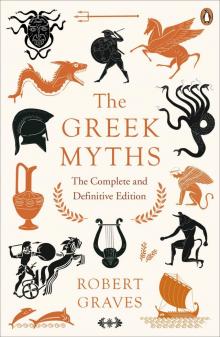- Home
- Robert Graves
The Greek Myths Page 6
The Greek Myths Read online
Page 6
He has borrowed the mechanism of his myth from analogous examples: Zeus pursuing Nemesis (see 32. b); Cronus swallowing his sons and daughters (see 7. a); Dionysus’s rebirth from Zeus’s thigh (see 14. c); and the opening of Mother Earth’s head by two men with axes, apparently in order to release Core (see 24. 3) – as shown for instance, on a black-figured oil-jar in the Bibliothèque Nationale at Paris. Thereafter, Athene is Zeus’s obedient mouthpiece, and deliberately suppresses her antecedents. She employs priests, not priestesses.
2. Pallas, meaning ‘maiden’, is an inappropriate name for the winged giant whose attempt on Athene’s chastity is probably deduced from a picture of her ritual marriage, as Athene Laphria, to a goat-king (see 89. 4) after an armed contest with her rival (see 8. 1). This Libyan custom of goat-marriage spread to Northern Europe as part of the May Eve merrymakings. The Akan, a Libyan people, once flayed their kings.
3. Athene’s repudiation of Poseidon’s fatherhood concerns an early change in the overlordship of the city of Athens (see 16. 3).
4. The myth of Itonus (‘willow-man’) represents a claim by the Itonians that they worshipped Athene even before the Athenians did; and his name shows that she had a willow cult in Phthiotis – like that of her counterpart, the goddess Anatha, at Jerusalem until Jehovah’s priests ousted her and claimed the rain-making willow as his tree at the Feast of Tabernacles.
5. It will have been death for a man to remove an aegis – the goat-skin chastity-tunic worn by Libyan girls – without the owner’s consent; hence the prophylactic Gorgon mask set above it, and the serpent concealed in the leather pouch, or bag. But since Athene’s aegis is described as a shield, I suggest in The White Goddess (p. 279) that it was a bag-cover for a sacred disk, like the one which contained Palamedes’s alphabetical secret, and which he is said to have invented (see 52. a and 162. 5). Cyrian figurines holding disks of the same proportionate size as the famous Phaestos one, which is spirally marked with a sacred legend, are held by Professor Richter to anticipate Athene and her aegis. The heroic shields so carefully described by Homer and Hesiod seem to have borne pictographs engraved on a spiral band,
6. Iodama, probably meaning ‘heifer calf of Io’, will have been an antique stone image of the Moon-goddess (see 56. 1), and the story of her petrification is a warning to inquisitive girls against violating the Mysteries (see 25. d).
7. It would be a mistake to think of Athene as solely or predominantly the goddess of Athens. Several ancient acropolises were sacred to her, including Argos (Pausanias: ii. 24. 3), Sparta (ibid.: 3. 17. 1), Troy (Iliad vi. 88), Smyrna (Strabo: iv. 1. 4), Epidaurus (Pausanias: ii. 32. 5), Troezen (Pausanias: iii. 23. 10), and Pheneus (Pausanias: x. 38. 5). All these are pre-Hellenic sites.
10
THE FATES
THERE are three conjoined Fates, robed in white, whom Erebus begot on Night: by name Clotho, Lachesis, and Atropos. Of these, Atropos is the smallest in stature, but the most terrible.1
b. Zeus, who weighs the lives of men and informs the Fates of his decisions can, it is said, change his mind and intervene to save whom he pleases, when the thread of life, spun on Clotho’s spindle, and measured by the rod of Lachesis, is about to be snipped by Atropos’s shears. Indeed, men claim that they themselves can, to some degree, control their own fates by avoiding unnecessary dangers. The younger gods, therefore, laugh at the Fates, and some say that Apollo once mischievously made them drunk in order to save his friend Admetus from death.2
c. Others hold, on the contrary, that Zeus himself is subject to the Fates, as the Pythian priestess once confessed in an oracle; because they are not his children, but parthenogenous daughters of the Great Goddess Necessity, against whom not even the gods contend, and who is called ‘The Strong Fate’.3
d. At Delphi only two Fates are worshipped, those of Birth and Death; and at Athens Aphrodite Urania is called the eldest of the three.4
1. Homer: Iliad xxiv. 49; Orphic Hymn xxxiii; Hesiod: Theogony 217 ff. and 904, Shield of Heracles 259.
2. Homer: Iliad viii. 69 and xxii. 209; xvi. 434 and 441–3; Virgil: Aeneid x. 814; Homer: Odyssey i. 34; Iliad ix. 411.
3. Aeschylus: Prometheus 511 and 515; Herodotus: i. 91; Plato: Republic x. 14–16; Simonides: viii. 20.
4. Pausanias: x. 24. 4 and i. 19. 2.
1. This myth seems to be based on the custom of weaving family and clan marks into a newly-born child’s swaddling bands, and so allotting him his place in society (see 60. 2); but the Moerae, or Three Fates, are the Triple Moon-goddess – hence their white robes, and the linen thread which is sacred to her as Isis. Clotho is the ‘spinner’, Lachesis the ‘measurer’, Atropos is ‘she who cannot be turned, or avoided’. Moera means ‘a share’ or ‘a phase’, and the moon has three phases and three persons: the new, the Maiden-goddess of the spring, the first period of the year; the full moon, the Nymph-goddess of the summer, the second period; and the old moon, the Crone-goddess of autumn, the last period (see 60. 2).
2. Zeus called himself ‘The Leader of the Fates’ when he assumed supreme sovereignty and the prerogative of measuring man’s life; hence, probably, the disappearance of Lachesis, ‘the measurer’, at Delphi. But his claim to be their father was not taken seriously by Aeschylus, Herodotus, or Plato.
3. The Athenians called Aphrodite Urania ‘the eldest of the Fates’ because she was the Nymph-goddess, to whom the sacred king had, in ancient times, been sacrificed at the summer solstice. ‘Urania’ means ‘queen of the mountains’ (see 19.3).
11
THE BIRTH OF APHRODITE
APHRODITE, Goddess of Desire, rose naked from the foam of the sea and, riding on a scallop shell, stepped ashore first on the island of Cythera; but finding this only a small island, passed on to the Peloponnese, and eventually took up residence at Paphos, in Cyprus, still the principal seat of her worship. Grass and flowers sprang from the soil wherever she trod. At Paphos, the Seasons, daughters of Themis, hastened to clothe and adorn her.
b. Some hold that she sprang from the foam which gathered about the genitals of Uranus, when Cronus threw them into the sea; others, that Zeus begot her on Dione, daughter either of Oceanus and Tethys the sea-nymph, or of Air and Earth. But all agree that she takes the air accompanied by doves and sparrows.1
1. Hesiod: Theogony 188–200 and 353; Festus Grammaticus: iii. 2; Homeric Hymn to Aphrodite ii. 5; Apollodorus: i. 1. 3.
1. Aphrodite (‘foam-born’) is the same wide-ruling goddess who rose from Chaos and danced on the sea, and who was worshipped in Syria and Palestine as Ishtar, or Ashtaroth (see 1. 1). Her most famous centre of worship was Paphos, where the original white aniconic image of the goddess is still shown in the ruins of a grandiose Roman temple; there every spring her priestess bathed in the sea, and rose again renewed.
2. She is called daughter of Dione, because Dione was the goddess of the oak-tree, in which the amorous dove nested (see 51. a). Zeus claimed to be her father after seizing Dione’s oracle at Dodona, and Dione therefore became her mother. ‘Tethys’ and ‘Thetis’ are names of the goddess as Creatrix (formed, like ‘Themis’ and ‘Theseus’, from tithenai, ‘to dispose’ or ‘to order’), and as Sea-goddess, since life began in the sea (see 2. a). Doves and sparrows were noted for their lechery; and sea food is still regarded as aphrodisiac throughout the Mediterranean.
3. Cythera was an important centre of Cretan trade with the Peloponnese, and it will have been from here that her worship first entered Greece. The Cretan goddess had close associations with the sea. Shells carpeted the floor of her palace sanctuary at Cnossus; she is shown on a gem from the Idean Cave blowing a triton-shell, with a sea-anemone lying beside her altar; the sea-urchin and cuttle-fish (see 81. 1) were sacred to her. A triton-shell was found in her early sanctuary at Phaestus, and many more in late Minoan tombs, some of these being terracotta replicas.
12
HERA AND HER CHILDREN
HERA, daughter of Cronus and Rhea, having been born on the island of Samos or,
some say, at Argos, was brought up in Arcadia by Temenus, son of Pelasgus. The Seasons were her nurses.1 After banishing their father Cronus, Hera’s twin-brother Zeus sought her out at Cnossus in Crete or, some say, on Mount Thornax (now called Cuckoo Mountain) in Argolis, where he courted her, at first unsuccessfully. She took pity on him only when he adopted the disguise of a bedraggled cuckoo, and tenderly warmed him in her bosom. There he at once resumed his true shape and ravished her, so that she was shamed into marrying him.2
b. All the gods brought gifts to the wedding; notably Mother Earth gave Hera a tree with golden apples, which was later guarded by the Hesperides in Hera’s orchard on Mount Atlas. She and Zeus spent their wedding night on Samos, and it lasted three hundred years. Hera bathes regularly in the spring of Canathus, near Argos, and thus renews her virginity.3
c. To Hera and Zeus were born the deities Ares, Hephaestus, and Hebe, though some say that Ares and his twin-sister Eris were conceived when Hera touched a certain flower, and Hebe when she touched a lettuce,4 and that Hephaestus also was her parthenogenous child – a wonder which he would not believe until he had imprisoned her in a mechanical chair with arms that folded about the sitter, thus forcing her to swear by the River Styx that she did not lie. Others say that Hephaestus was her son by Talos, the nephew of Daedalus.5
1. Pausanias: vii. 4. 4 and viii. 22. 2; Strabo: ix. 2. 36; Olen, quoted by Pausanias: ii. 13. 3.
2. Diodorus Siculus: v. 72; Pausanias ii. 36. 2 and 17. 4.
3. Scholiast on Homer’s Iliad i. 609; Pausanias: ii. 38. 2.
4. Homer: Iliad iv. 441; Ovid: Fasti v. 255; First Vatican Mythographer: 204.
5. Servius on Virgil’s Eclogues iv. 62; Cinaethon, quoted by Pausanias: viii. 53. 2.
1. Hera’s name, usually taken to be a Greek word for ‘lady’, may represent an original Herwā (‘Protectress’). She is the pre-Hellenic Great Goddess. Samos and Argos were the chief seats of her worship in Greece, but the Arcadians claimed that their cult was the earliest, and made it contemporary with their earth-born ancestor Pelasgus (‘ancient’). Hera’s forced marriage to Zeus commemorates conquests of Crete and Mycenaean – that is to say Cretanized – Greece, and the overthrow of her supremacy in both countries. He probably came to her disguised as a bedraggled cuckoo, in the sense that certain Hellenes who came to Crete as fugitives accepted employment in the royal guard, made a palace conspiracy and seized the kingdom. Cnossus was twice sacked, apparently by Hellenes; about 1700 B.C., and about 1400 B.C.; and Mycenae fell to the Achaeans a century later. The God Indra in the Ramayana had similarly wooed a nymph in cuckoo disguise; and Zeus now borrowed Hera’s sceptre, which was surmounted with the cuckoo. Gold-leaf figurines of a naked Argive goddess holding cuckoos have been found at Mycenae; and cuckoos perch on a gold-leaf model temple from the same site. In the well-known Cretan sarcophagus from Hagia Triada a cuckoo perches on a double-axe.
2. Hebe, the goddess as child, was made cup-bearer to the gods in the Olympian cult. She eventually married Heracles (see 145.i and 5), after Ganymedes had usurped her office (see 29. c). ‘Hephaestus’ seems to have been a title of the sacred king as solar demi-god; ‘Ares’, a title of his war-chief, or tanist, whose emblem was the wild boar. Both became divine names when the Olympian cult was established and they were chosen to fill the roles, respectively, of War-god and Smith-god. The ‘certain flower’ is likely to have been the may-blossom: Ovid makes the goddess Flora – with whose worship the may-blossom was associated – point it out to Hera. The may, or whitethorn, is connected with miraculous conception in popular European myth: in Celtic literature its ‘sister’ is the blackthorn, a symbol of Strife – Ares’s twin, Eris.
3. Talos, the smith, was a Cretan hero born to Daedalus’s sister Perdix (‘partridge’), with whom the mythographer is identifying Hera. Partridges, sacred to the Great Goddess, figured in the spring equinox orgies of the Eastern Mediterranean, when a hobbling dance was performed in imitation of cock-partridges. The hens were said by Aristotle, Pliny, and Aelian to conceive merely by hearing the cock’s voice. Hobbling Hephaestus and Talos seem to be the same parthenogenous character; and both were cast down from a height by angry rivals (see 23. b and 92. b) –originally in honour of their goddess-mother.
4. In Argos, Hera’s famous statue was seated on a throne of gold and ivory; the story of her imprisonment in a chair may have arisen from the Greek custom of chaining divine statues to their thrones ‘to prevent escape’. By losing an ancient statue of its god or goddess, a city might forfeit divine protection, and the Romans, therefore, made a practice of what was politely called ‘enticing’ gods to Rome – which by Imperial times had become a jackdaw’s nest of stolen images. ‘The Seasons were her nurses’ is one way of saying that Hera was a goddess of the calendar year. Hence the spring cuckoo on her sceptre, and the ripe pomegranate of late autumn, which she carried in her left hand to symbolize the death of the year.
5. A hero, as the word indicates, was a sacred king who had been sacrificed to Hera, whose body was safely under the earth, and whose soul had gone to enjoy her paradise at the back of the North Wind. His golden apples, in Greek and Celtic myth, were passports to this paradise (see 53. 7, 133. 4, and 159. 3).
6. The annual bath with which Hera renewed her virginity was also taken by Aphrodite at Paphos; it seems to have been the purification ceremony prescribed to a Moon-priestess after the murder of her lover, the sacred king (see 22. 1 and 150. 1). Hera, being the goddess of the vegetative year, spring, summer and autumn (also symbolized by the new, full, and old moon) was worshipped at Stymphalus as Child, Bride, and Widow (Pausanias: vii. 22. 2 – see 128. d).
7. The wedding-night on Samos lasted for three hundred years: perhaps became the Samian sacred year, like the Etruscan one, consisted of ten thirty-day months only: with January and February omitted (Macrobius: i. 13). Each day was lengthened to a year. But the mythographer may here be hinting that it took the Hellenes three hundred years before they forced monogamy on Hera’s people.
13
ZEUS AND HERA
ONLY Zeus, the Father of Heaven, might wield the thunderbolt; and it was with the threat of its fatal flash that he controlled his quarrelsome and rebellious family of Mount Olympus. He also ordered the heavenly bodies, made laws, enforced oaths, and pronounced oracles. When his mother Rhea, foreseeing what trouble his lust would cause, forbade him to marry, he angrily threatened to violate her. Though she at once turned into a menacing serpent, this did not daunt Zeus, who became a male serpent and, twining about her in an indissoluble knot, made good his threat.1 It was then that he began his long series of adventures in love. He fathered the Seasons and the Three Fates on Themis; the Charites on Eurynome; the Three Muses on Mnemosyne, with whom he lay for nine nights; and, some say, Persephone, the Queen of the Underworld, whom his brother Hades forcibly married, on the nymph Styx.2 Thus he lacked no power either above or below earth; and his wife Hera was equal to him in one thing alone: that she could still bestow the gift of prophecy on any man or beast she pleased.3
b. Zeus and Hera bickered constantly. Vexed by his infidelities, she often humiliated him by her scheming ways. Though he would confide his secrets to her, and sometimes accept her advice, he never fully trusted Hera, and she knew that if offended beyond a certain point he would flog or even hurl a thunderbolt at her. She therefore resorted to ruthless intrigue, as in the matter of Heracles’s birth; and sometimes borrowed Aphrodite’s girdle, to excite his passion and thus weaken his will. He now claimed to be Cronus’s first-born son.4
c. A time came when Zeus’s pride and petulance became so intolerable that Hera, Poseidon, Apollo, and all the other Olympians, except Hestia, surrounded him suddenly as he lay asleep on his couch and bound him with rawhide thongs, knotted into a hundred knots, so that he could not move. He threatened them with instant death, but they had placed his thunderbolt out of reach and laughed insultingly at him. While they were celebrating their victory, and jealously discussing who was
to be his successor, Thetis the Nereid, foreseeing a civil war on Olympus, hurried in search of the hundred-handed Briareus, who swiftly untied the thongs, using every hand at once, and released his master. Because it was Hera who had led the conspiracy against him, Zeus hung her up from the sky with a golden bracelet about either wrist and an anvil fastened to either ankle. The other deities were vexed beyond words, but dared attempt no rescue for all her piteous cries. In the end Zeus undertook to free her if they swore never more to rebel against him; and this each in turn grudgingly did. Zeus punished Poseidon and Apollo by sending them as bond-servants to King Laomedon, for whom they built the city of Troy; but he pardoned the others as having acted under duress.5
1. Orphic Fragment 58; Hesiod: Theogony 56.
2. Apollodorus: i. 3. 1–2.
3. Homer: Iliad xix. 407.
4. Ibid.: i. 547; xvi. 458; viii. 407–8; xv. 17; viii. 397–404; xiv. 197–223; xv. 166.
5. Scholiast on Homer’s Iliad xxi. 444; Tzetzes: On Lycophron 34; Homer: Iliad i. 399 ff. and xv. 18–22.
1. The marital relations of Zeus and Hera reflect those of the barbarous Dorian Age, when women had been deprived of all their magical power, except that of prophecy, and come to be regarded as chattels. It is possible that the occasion on which the power of Zeus was saved only by Thetis and Briareus, after the other Olympians had conspired against him, was a palace revolution by vassal princes of the Hellenic High King, who nearly succeeded in dethroning him; and that help came from a company of loyal non-Hellenic household troops, recruited in Macedonia, Briareus’s home, and from a detachment of Magnesians, Thetis’s people. If so, the conspiracy will have been instigated by the High-priestess of Hera, whom the High King subsequently humiliated, as the myth describes.

 The Greek Myths, Volume2
The Greek Myths, Volume2 The Anger of Achilles: Homer's Iliad
The Anger of Achilles: Homer's Iliad Count Belisarius
Count Belisarius The Twelve Caesars
The Twelve Caesars Complete Poems 3 (Robert Graves Programme)
Complete Poems 3 (Robert Graves Programme) Homer's Daughter
Homer's Daughter The White Goddess
The White Goddess Goodbye to All That
Goodbye to All That Claudius the God and His Wife Messalina
Claudius the God and His Wife Messalina The Greek Myths
The Greek Myths I, Claudius
I, Claudius The Islands of Unwisdom
The Islands of Unwisdom Complete Short Stories
Complete Short Stories The Golden Fleece
The Golden Fleece They Hanged My Saintly Billy
They Hanged My Saintly Billy King Jesus
King Jesus Sergeant Lamb's America
Sergeant Lamb's America Hebrew Myths: The Book of Genesis
Hebrew Myths: The Book of Genesis Seven Days in New Crete
Seven Days in New Crete Proceed, Sergeant Lamb
Proceed, Sergeant Lamb Claudius the God
Claudius the God Wife to Mr. Milton
Wife to Mr. Milton The Complete Poems
The Complete Poems The Anger of Achilles
The Anger of Achilles Claudius the God c-2
Claudius the God c-2 Hebrew Myths
Hebrew Myths I, Claudius c-1
I, Claudius c-1 The Greek Myths, Volume 1
The Greek Myths, Volume 1